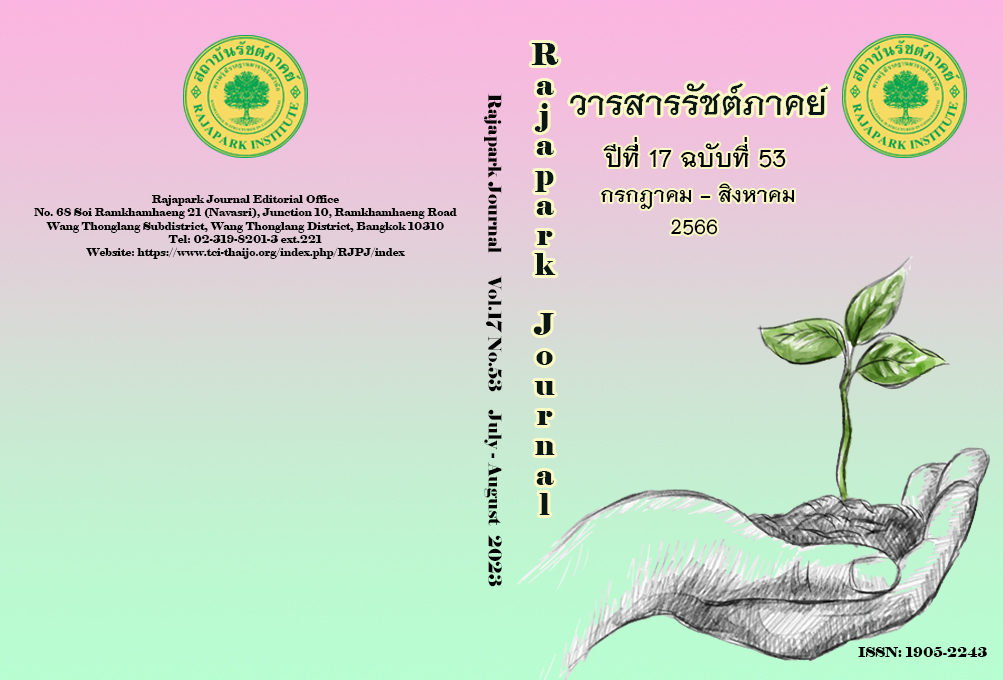Using English Songs to Enhance Linking Sound’s Awareness
Main Article Content
Abstract
This study investigated the effects of using English songs to enhance the awareness of linking sound in terms of consonant-to-vowel linking and views of ninth-grade students toward the use of songs in the EFL classroom in Bangkok, Thailand. The study was designed as quasi-experimental research. Thirty participants studying in ninth grade (Mattayomsuksa 3) were selected through the purposive sampling method in the experiment. The research instruments were English songs selected from a survey conducted from a pilot study of ninth-grade students, a listening pre-test and post-test for linking sounds, lesson plans, and interview questions, which were confirmed for reliability and validity by three experts. The quantitative data were collected through the pre-test and post-test, and the scores were analyzed through dependent T-test. Moreover, the qualitative data were collected through interviews with open-ended questions. The study results showed that the achievement of the post-test’s scores was higher than the pre-test’s scores, indicating that English songs could improve students’ awareness of consonant-to-vowel linking. In addition, most students reported that songs could help them recognize the linking sounds since the songs provided authentic English and several samples of linking sounds, making language learning attractive. Moreover, students preferred to learn through songs because songs offered an entertaining and relaxing atmosphere in class and were more interesting than other materials. In addition, songs are conveniently applied to students when practicing listening skills for linking sound.
Article Details

This work is licensed under a Creative Commons Attribution-NonCommercial-NoDerivatives 4.0 International License.
Views and opinions appearing in the Journal it is the responsibility of the author of the article, and does not constitute the view and responsibility of the editorial team.
References
Alameen, G. (2007). The Use of Linking by Native and Non-native Speakers of American English. Iowa State University.
Alameen, G., & Levis, J. M. (2015). Connected Speech. The Handbook of English Pronunciation, 157-174.
Arleo, A. (2000). Music, Song and Foreign Language Teaching. Cahiers de l'APLIUT, 19(4), 5-19.
Ashtiani, F. T., & Zafarghandi, A. M. (2015). The Effect of English Verbal Songs on Connected Speech Aspects of Adult English Learners’ Speech Production. Advances in Language and Literary Studies, 6(1), 212-226.
Brown, H.D. (2001). Teaching by Principles: An Interactive Approach to Language Pedagogy. Longman.
Gardner, H. (1998). Is Musical Intelligence Special?. The Choral Journal, 38(8), 23-34.
Hariwongsanuparp, P. (2015). Barriers to Success of non - Thai Students’ Learning Thai as a Foreign Language at an International School[Independent Study, Thammasat Unversity].
Israel, H. F. (2013). Language Learning Enhanced by Music and Song. Literacy Information and Computer Education Journal, 2(1), 1360-1366.
Johansson, J. (2021). Benefits of Songs in the ESL Classroom[Independent Thesis, Malmö University]. http://www.diva-portal.org/smash/get/diva2:1538697/FULLTEXT02.pdf
Kanokpermpoon, M. (2007). Thai and English Consonantal Sounds: A Problem or a Potential for EFL Learning?. ABAC Journal, 27(1), 57-66. http://www.assumptionjournal.au.edu/index.php/abacjournal/article/view/583
Lawthong, N. (2016). Construction of Educational Research Tools. Chulalongkorn University Press.
Melenca, M. A. (2001). Teaching Connected Speech Rules to Japanese Speakers of English so as to Avoid a Staccato Speech Rhythm[Master’s Thesis, Concordia University].
Newton, J. M., & Nation, I. (2020). Teaching ESL/EFL Listening and Speaking (2nd ed.). Routledge.
Nhat, Nguyen Thi Hong. (2021). Developing Bottom-up Listening Skills in a Google Classroom-based EFL Module. AsiaCALL Online Journal, 12(3), 47-57. https://asiacall.info/acoj/index.php/journal/article/view/45
Niamthet, T. (2016). A Survey of Awareness Towards English Pronunciation among Thai International Workers in Exhibition Services[Master’s Thesis, Thammasat University].
Nunan, D. (1997). Approaches to Teaching Listening in the Language Classroom. In Proceedings of the 1997 Korea TESOL Conference, October 3-5. (pp. 1-10). Kyoung-ju, South Korea. https://koreatesol.org/sites/default/files/pdf_publications/KOTESOL-Proceeds1997web.pdf
Pardede, P. (2019). Employing Music and Songs in EFL Classrooms. In PROCEEDING English Education Department Collegiate Forum (EED CF) 2015-2018. (pp. 251-264). UKI Press, Indonesia, Jakarta.
Phuangsua, K., & Chusanachoti, R. (2019). A Study of Out-of-Class English Language Listening Activities of Lower Secondary School Students. Journal of Education Studies, 47(4), 38-64. https://so02.tci-thaijo.org/index.php/EDUCU/article/view/231836
Soosongdee, Y., & Rattanawanitpun, S. (2012). English Listening Competency for Communication of the 5 Level Secondary Students under the Secondary Educational Service Area Office 33 in Surin Province. Nakhon Phanom University Journal, 2(1), 51-57.
Stanculea, A.N., & Bran, C. (2015). Teaching Pronunciation Through Songs. Journal Plus Education, 13(2), 172-179.
Study.com. (2021, Jan 26). Bottom Up & Top Down Teaching Strategies. https://study.com/academy/lesson/bottom-up-top-down-teaching-strategies.html
Ulum, Ö. G. (2015). Listening: The Ignored Skill in EFL Context. Online Submission, 2(5), 72-76.
Yule, G. (2022). The Study of Language. Cambridge University Press.


